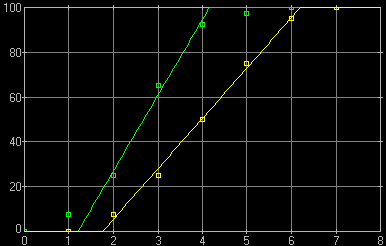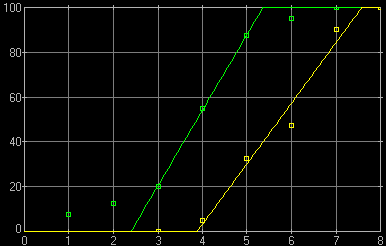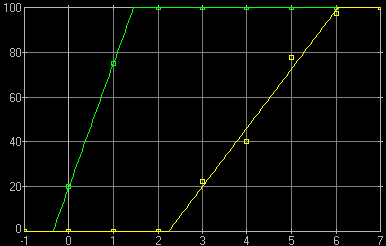
|
Image Stabilization in Olympus E-M1 Measured and Discussed |

| My other articles related to the Olympus OM-D System. |
|
The new Olympus wunderkind, the E-M1 is, indeed, a camera I like a lot — almost all of it. Like other Olympus μFT cameras (and FT ones before), it uses a body-based image stabilization system, compensating for the camera shake with small movements of the image sensor. We have seen this system work in the past, so it should work here just fine, too. No doubts about it.
In the promotional literature about this model, Olympus says it is "equipped with the world’s first 5-Axis image stabilization system with IS-Auto" which "compensates for vertical, horizontal and rotational camera shake that conventional 2-axis systems could not". Hey, not bad! We beat the competition by 150% in number of dimensions — this system must be better than others (including those we had in our older cameras). Let me digress a bit more: the promotional passage was composed so that you cannot tell if [1] this is the first 5-axis system and it also has IS-Auto (whatever that is, probably a proprietary name), or [2] it is the first system having both a 5-Axis design and IS-Auto. Clearly, the follow-up suggests [1], but the company may say they meant just [2]. Go figure. Back in 2007 I developed a statistically and numerically sound procedure for defining and measuring the benefits of image stabilization in cameras. Indeed, having worked in areas of numerical and statistical analysis for forty years, I felt qualified for that. The procedure retains one of the most unreliable elements of the process: the human behind the camera, but I tried to minimize the impact of that, and the results turned out quite reproducible. The procedure — briefly Before we get to the results, I owe you some information about what they mean, lest we go the "four legs good, two legs bad" way (very much like most of the Web nowadays). The procedure is described in detail in a separate article, and a general introduction to the subject — in yet another one. For comparison, see also the results for the E-510 and E-3 Olympus SLRs. Briefly and roughly, the procedure (at a given, fixed focal length) involves shooting a number of frames (here: 20) at every whole-stop shutter speed in a wide interval, and then anonymous image evaluation to count the number of "good" frames at each speed. Finally, a numerical algorithm is used to determine the values of two parameters:
The v-values are not expressed in seconds, but rather as an offset (in EV) from the 1-second shutter speed; for example, v=2 is 1/4 s and v=3 — 1/8 s. One EV means doubling or halving the exposure, thus This sequence of shutter speeds is done twice: with and without image stabilization. Each of these two series results in its own v50 and v100; the change brought by IS to them is a good definition of the benefits of the IS process:
The related exposure multipliers can be computed as While semantically I somewhat prefer the 100% value, the 50% one is more robust statistically, so I decided to keep it as my baseline IS metric. Still, I'm showing both, so take your pick.
|
All numeric values resulting from the procedure are listed in the Appendix; here I'm showing only the data points and best-fit lines describing how the success rate varies with shutter speed.
The horizontal spacing between lines at the top (100%) is Δv100, that at the 50% height is Δv50. This experiment was done using the E-M1 (firmware 1.1, unless stated otherwise) and two lenses. For each focal length the process (shooting, evaluation, data processing, checking, and report formatting) takes a good few hours, therefore I decided to do only two focal lengths:
Update of 2017: I'm adding one more lens to the report:
This lens has its own, internal IS system, which is supposed to work together with the sensor-based one, an Olympus standard. It is said that this dual-IS approach offers sigmificant IS benefits and I wanted to check this claim. My E-M1 was recently updated to firmware Version 4.3. I am not sure which version introduced support for dual IS. Now, the beef. | |
|
50 mm (12-50/3.5-6.3) The effect of image stabilization is
While this is close to my results for the E-510 at 42 mm and E-3 at 60 mm, the widening gain at 100% may not be a fluke, but a result of the new system being more efficient at higher speeds.
|

|
|
300 mm (70-300/4.8-6.7) The IS effect is
I never before used this method for 300 mm, but suspected that the IS benefits are greater at longer focal lengths, and it may be true when we compare this with the numbers above. |

|
|
(2017) This is a very different lens, using its own, internal IS system (in addition to the in-body one). The results shown are not representative for any other lenses at 100 mm. The IS effect is
|

Success rate vs. shutter speed (EV from 1s) |
|
Conclusions
After going through all this data, I can say the following:
Note of 2017: A dramatic change was, however, introduced by the recent IS lenses, as shown in our 100 mm case. Looks like this dual-IS system works very nicely with the E-M1 (updated firmware?), expanding handheld exposure range by (close to) 2 EV, close to the results on the E-M1 Mk.II. Last but not least, remember that each EV in usable ISO settings replaces one EV in AF effectiveness. With at least two EV gained in ISO since the last E-series SLRs, we already experience an effect equivalent to 2 extra EV in image stabilization. While the hard-tech market, driven by specs and marketing blurb, may be hard to convince, I still think that image stabilization in still photography may be a transitional technology, going soon the way of the dodo. |
|
Appendix: The v coefficients and exposure times
The values of v0 and v100, and v50 are as described above and, in more detail, in the separate article on the method I'm using. The improvement (IS versus no IS) in v100 or in v50, which can be used to describe the benefits of image stabilization is shown in the last two columns.
Updated 2017/02/28: added data for 100 mm, obtained with the MZD 12-100 IS PRO lens — for comparison with the Mark II results.
|
| ||||||||||||||||||||||||||||||||||||||||||
|
Note: The 100 mm, IS ON value of v100=1.455 is a bit surprising, being better than 2.062 reported for the This cannot be helped; the only way would be decreasing the spacing between tested shutter speeds to 1/3 EV; this, however, would be quite prohibitive. |

| My other articles related to the Olympus OM-D System. |
| This page is not sponsored or endorsed by Olympus (or anyone else) and presents solely the views of the author. |
| Home: wrotniak.net | Search this site | Change font size |
| Posted 2013/12/15; last updated 2017/02/27 | Copyright © 2013-2017 by J. Andrzej Wrotniak |